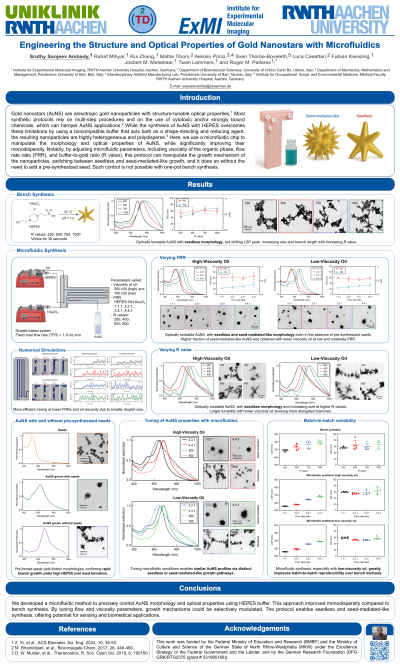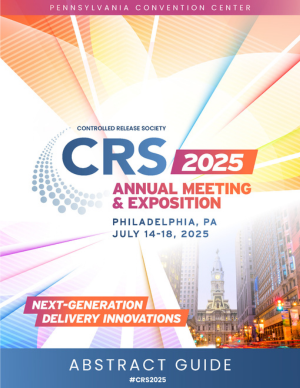Manufacturing and Process Scale-Up
(259) Engineering the structural and optical properties of gold nanostars with microfluidics

Introduction: Gold nanostars (AuNS) are anisotropic nanoparticles with tunable optical properties in the near infrared (NIR) region, where light has deep tissue-penetrating capacity, enabling photothermal therapy and photoacoustic imaging.[1] Most conventional protocols involve multi-step processes and cytotoxic chemicals, which often limit applicability.[2] Synthesizing and reducing AuNS with HEPES buffer overcomes these issues, but yields polydisperse AuNS.[3,4] Here we use a microfluidic chip to better control the morphology and optical properties of AuNS, significantly improving their monodispersity.
Learning Objectives:
- Study the microfluidic synthesis of AuNS with HEPES, a Good’s buffer via seedless method
- Explore the effect of oil viscosity, FRR and R value on optical and morphological aspects of AuNS
- Manipulate the growth and physicochemical features of AuNS for targeted applications
Rahaf Mihyar – PhD student, Uniklinik RWTH Aachen, Institute for Experimental Molecular Imaging, Aachen, Germany; Rui Zhang – PhD student, Uniklinik RWTH Aachen, Institute for Experimental Molecular Imaging, Aachen, Germany; Mattia Tiboni – Research Fellow, University of Urbino Department of Biomolecular Sciences; Luca Casettari – Full Professor, Universita degli Studi di Urbino Carlo Bo, Dipartimento di Scienze Biomolecolari; Fabian Kiessling – Professor and Director, ExMI, Aachen, Germany, Uniklinik RWTH Aachen, Institute for Experimental Molecular Imaging (ExMI), Aachen, Germany; Josbert Metselaar – Part-time group leader, Rheinisch-Westfalische Technische Hochschule Aachen, Ringgold standard institution - Experiemntal Molcular Imaging; Twan Lammers – Professor, Rheinisch Westfalische Technische Hochschule Aachen, Experimental Molecular Imaging; Roger Pallares – Head of the Biohybrid Nanomedical Materials Group, Uniklinik RWTH Aachen, ExMI

Sruthy Sanjeev Ambady, MSc (she/her/hers)
PhD student
Institute for Experimental Molecular Imaging, Uniklinik RWTH Aachen, Aachen, Germany
Aachen, Nordrhein-Westfalen, Germany

